Enhancing the Impact Strength of Prepacked Aggregate Fibrous Concrete Using Asphalt-Coated Aggregates
Abstract
:1. Introduction
2. A Design Approach Based on the Theory of High-Speed Impact
3. Experimental Work
3.1. Materials
3.2. Process of Applying Asphalt Coating to Aggregates
3.3. Mix Combinations
3.4. Specimen Preparation Procedure
3.5. Impact Test Device and Methodology
4. Discussion of Results
4.1. Influence of Asphalt Coating on Compressive Strength
4.2. Influence of Fibre Type on Compressive Strength
4.3. Impact Test Results
4.3.1. Effect of Asphalt Coating on Impact Energies
4.3.2. Effect of Fibre Type on Impact Energies
4.3.3. Ductility Index of PAFC
4.3.4. Failure Mode of TSFC
4.3.5. Mechanism of PAFC Failure
5. Conclusions
- A reduced compressive strength was observed when natural aggregate was replaced for either a single or double layer of asphalt-coated aggregate. Compared to the natural aggregate specimens, the compressive strength of the single- and double-coated specimens without fibres was reduced by 5.08 and 11.02%, respectively. Similarly, 5.97 and 7.67% lower compressive strengths were found in the P-PF C1 and P-PF C2 specimens as compared to the P-PF specimen, while the compressive strength was reduced by 3.95 and 5.53% for P-SF-C1 and P-SF-C2 specimens, respectively, as compared to P-SF specimens.
- Compared to NC, the compressive strength of the PF and SF-based specimens containing 100% natural aggregate increased by 25.17 and 48.06%, respectively. Fibrous specimens with single and double coatings showed a similar trend of strength enhancement. Fibres played a significant role in this development owing to their extraordinary ability to bridge micro and macro cracks.
- Impact energies (EO1 and EO2) increased from a single layer of asphalt coating to a double layer. The EO1 and EO2 values of the single asphalt-coated aggregate specimens were 1.55 and 2.11 times higher than the natural aggregate specimens, respectively. The EO1 and EO2 values were 1.73 and 2.56 times greater for the double asphalt-coated specimens. An excellent post-cracking resistance was seen in the specimens when single- and double-layer asphalt-coated aggregates were employed.
- The impact energy was improved by adding asphalt-coated aggregate into PAFC. The EO1 and EO2 values of the P-PF-C1 specimens were 1.85 and 2.91 times greater than those of NC-C1. These values were much greater in the P-SF-C1 specimens (by 2.65 and 8.79 times, respectively). There was a similar increase in strength in the double-coated aggregate fibrous concrete, which were 1.76 and 2.81 times greater EO1 and EO2 values for P-PF C2 specimens than NC-C2 specimens. For the P-SF-C2 specimens, the EO1 and EO2 values were 2.45 and 7.75 times higher than the NC-C2 specimen.
- The post-cracking resistance of PAFC was improved significantly by adding fibres and marginally by adding asphalt-coated aggregate. The impact ductility index for the asphalt-coated aggregate improved from 1.2 to 1.8 for non-fibrous concrete, 2.4 to 2.9 for PF-based fibrous concrete and 5.3 to 5.8 for SF-based fibrous concrete. A brittle failure was observed in all non-fibrous specimens, while a ductile failure was observed in fibrous specimens irrespective of asphalt-coated aggregate usage.
Author Contributions
Funding
Institutional Review Board Statement
Informed Consent Statement
Data Availability Statement
Acknowledgments
Conflicts of Interest
References
- Murali, G.; Vinodha, E. Experimental and Analytical Study of Impact Failure Strength of Steel Hybrid Fibre Reinforced Concrete Subjected to Freezing and Thawing Cycles. Arab. J. Sci. Eng. 2018, 43, 5487–5497. [Google Scholar] [CrossRef]
- Murali, G.; Santhi, A.S.; Mohan Ganesh, G. Effect of crimped and hooked end steel fibres on the impact resistance of concrete. J. Appl. Sci. Eng. 2014, 17, 259–266. [Google Scholar] [CrossRef]
- Soufeiani, L.; Raman, S.N.; Jumaat, M.Z.B.; Alengaram, U.J.; Ghadyani, G.; Mendis, P. Influences of the volume fraction and shape of steel fibers on fiber-reinforced concrete subjected to dynamic loading—A review. Eng. Struct. 2016, 124, 405–417. [Google Scholar] [CrossRef]
- Lu, S.; Xu, J.Y.; Bai, E.L.; Luo, X. Effect of particles with different mechanical properties on the energy dissipation properties of concrete. Constr. Build. Mater. 2017, 144, 502–515. [Google Scholar] [CrossRef]
- Ma, L.; Li, Z.; Liu, J.; Duan, L.; Wu, J. Mechanical properties of coral concrete subjected to uniaxial dynamic compression. Constr. Build. Mater. 2019, 199, 244–255. [Google Scholar] [CrossRef]
- Li, N.; Long, G.; Li, W.; Ma, C.; Zeng, X.; Xie, Y.; Li, H.; Yang, H. Designing high impact-resistance self-compacting concrete by addition of asphalt-coated coarse aggregate. Constr. Build. Mater. 2020, 253, 118758. [Google Scholar] [CrossRef]
- Abid, S.R.; Gunasekaran, M.; Ali, S.H.; Kadhum, A.L.; Al-Gasham, T.S.; Fediuk, R.; Vatin, N.; Karelina, M. Impact performance of steel fiber-reinforced self-compacting concrete against repeated drop weight impact. Crystals 2021, 11, 91. [Google Scholar] [CrossRef]
- Murali, G.; Abid, S.R.; Mugahed Amran, Y.H.; Abdelgader, H.S.; Fediuk, R.; Susrutha, A.; Poonguzhali, K. Impact performance of novel multi-layered prepacked aggregate fibrous composites under compression and bending. Structures 2020, 28, 1502–1515. [Google Scholar] [CrossRef]
- Asrani, N.P.; Murali, G.; Parthiban, K.; Surya, K.; Prakash, A.; Rathika, K.; Chandru, U. A feasibility of enhancing the impact resistance of hybrid fibrous geopolymer composites: Experiments and modelling. Constr. Build. Mater. 2019, 203, 56–68. [Google Scholar] [CrossRef]
- Kathirvel, P.; Murali, G.; Vatin, N.I.; Abid, S.R. Experimental Study on Self Compacting Fibrous Concrete Comprising Magnesium Sulphate Solution Treated Recycled Aggregates. Materials 2022, 15, 340. [Google Scholar] [CrossRef]
- Salaimanimagudam, M.P.; Suribabu, C.R.; Murali, G.; Abid, S.R. Impact response of hammerhead pier fibrous concrete beams designed with topology optimization. Period. Polytech. Civ. Eng. 2020, 64, 1244–1258. [Google Scholar] [CrossRef]
- Mohammadhosseini, H.; Alrshoudi, F.; Tahir, M.M.; Alyousef, R.; Alghamdi, H.; Alharbi, Y.R.; Alsaif, A. Performance evaluation of novel prepacked aggregate concrete reinforced with waste polypropylene fibers at elevated temperatures. Constr. Build. Mater. 2020, 259, 120418. [Google Scholar] [CrossRef]
- Alrshoudi, F.; Mohammadhosseini, H.; Tahir, M.M.; Alyousef, R.; Alghamdi, H.; Alharbi, Y.; Alsaif, A. Drying shrinkage and creep properties of prepacked aggregate concrete reinforced with waste polypropylene fibers. J. Build. Eng. 2020, 32, 101522. [Google Scholar] [CrossRef]
- Murali, G.; Ramprasad, K. A feasibility of enhancing the impact strength of novel layered two stage fibrous concrete slabs. Eng. Struct. 2018, 175, 41–49. [Google Scholar] [CrossRef]
- Abirami, T.; Loganaganandan, M.; Murali, G.; Fediuk, R.; Vickhram Sreekrishna, R.; Vignesh, T.; Januppriya, G.; Karthikeyan, K. Experimental research on impact response of novel steel fibrous concretes under falling mass impact. Constr. Build. Mater. 2019, 222, 447–457. [Google Scholar] [CrossRef]
- Abirami, T.; Murali, G.; Saravana Raja Mohan, K.; Salaimanimagudam, M.P.; Nagaveni, P.; Bhargavi, P. Multi-layered two stage fibrous composites against low-velocity falling mass and projectile impact. Constr. Build. Mater. 2020, 248, 118631. [Google Scholar] [CrossRef]
- Manohar, T.; Suribabu, C.R.; Murali, G.; Salaimanimagudam, M.P. A novel steel-PAFRC composite fender for bridge pier protection under low velocity vessel impacts. Structures 2020, 26, 765–777. [Google Scholar] [CrossRef]
- Jian, C.; Hong, H.; Yanchao, S. Discussion on the suitability of concrete constitutive models for high-rate response predictions of RC structures. Int. J. Impact Eng. 2017, 107, 202–216. [Google Scholar]
- Wang, L.Z.; Lu, S.; Liu, X.Y.; Niu, X.F.; Wang, C.; Ni, Y.K.; Zhao, M.Y.; Feng, C.L.; Zhang, M.; Fan, Y.B. Biomechanism of impact resistance in the woodpecker’s head and its application. Sci. China Life Sci. 2013, 56, 715–719. [Google Scholar] [CrossRef] [Green Version]
- Brand, A.S.; Roesler, J.R. Ternary concrete with fractionated reclaimed asphalt pavement. ACI Mater. J. 2015, 112, 155–163. [Google Scholar] [CrossRef]
- Ibrahim, A.; Mahmoud, E.; Khodair, Y.; Patibandla, V.C. Fresh, Mechanical, and Durability Characteristics of Self-Consolidating Concrete Incorporating Recycled Asphalt Pavements. J. Mater. Civ. Eng. 2014, 26, 668–675. [Google Scholar] [CrossRef]
- IS 1489(Part 1); 2015 Portland Pozzolana Cement-Specification. IS 1489 (Part 1) (Third Rev.). BIS: New Delhi, India, 2015.
- ASTM:C939-10; Standard Test Method for Flow of Grout for Preplaced-Aggregate Concrete (Flow Cone Method). ASTM International: West Conshohocken, PA, USA, 2010; Volume 4, pp. 9–11. [CrossRef]
- IS: 1206 (Part III)—1978 Edition 2.1 Indian Standard; Methods for Testing Tar and Bituminous Materials: Determination of Viscosity, Part III Kinematic Viscosity. (2005-05). BIS: New Delhi, India, 2007.
- IS: 1206 (Part II)—1978 Edition 2.2 Indian Standard; Methods for Testing Tar and Bituminous Materials: Determination of Viscosity Part II Absolute Viscosity. (2004-12). BIS: New Delhi, India, 2007.
- IS: 1208—1978 Edition 2.1 Indian Standard; Methods for Testing Tar and Bituminous Materials: Determination of Ductility. (2004-10). BIS: New Delhi, India, 2007.
- IS: 1206 (Part I)—1978 Edition 2.1 Indian Standard; Methods for Testing Tar and Bituminous Materials: Determination of Viscosity, Part I Industrial Viscosity. (2004-10). BIS: New Delhi, India, 2007.
- IS: 1205-1978 Indian Standard; Methods for Testing Tar and Bituminous Materials: Determination of Softening Point (1978). BIS: New Delhi, India, 2007.
- IS: 1203-1989-03; Indian Standard, Methods for Testing Tar and Bituminous Materials: Determination of Penetration (1989). BIS: New Delhi, India, 2007.
- ACI 544.2R-89; Measurement of Properties of Fiber Reinforced Concrete. ACI Committee: Farmington Hills, MI, USA, 1999; Volume 89, pp. 1–12.
- Debbarma, S.; Ransinchung, G.D.; Singh, S. Feasibility of roller compacted concrete pavement containing different fractions of reclaimed asphalt pavement. Constr. Build. Mater. 2019, 199, 508–525. [Google Scholar] [CrossRef]
- Brand, A.S.; Roesler, J.R. Bonding in cementitious materials with asphalt-coated particles: Part I—The interfacial transition zone. Constr. Build. Mater. 2017, 130, 171–181. [Google Scholar] [CrossRef] [Green Version]
- Brand, A.S.; Roesler, J.R. Bonding in cementitious materials with asphalt-coated particles: Part II—Cement-asphalt chemical interactions. Constr. Build. Mater. 2017, 130, 182–192. [Google Scholar] [CrossRef]
- Mohan, K.S.R.; Diviyabharrathi, K.B.; Murali, G. Research on the Development of High Impact Resistant Preplaced Aggregate Fibrous Concrete by the Inclusion of Coarse Aggregates Coated with Asphalt. Arab. J. Sci. Eng. 2021, 1–22. [Google Scholar] [CrossRef]
- Abid, S.R.; Murali, G.; Amran, M.; Vatin, N.; Fediuk, R.; Karelina, M. Evaluation of mode II fracture toughness of hybrid fibrous geopolymer composites. Materials 2021, 14, 349. [Google Scholar] [CrossRef]
- Li, J.J.; Niu, J.G.; Wan, C.J.; Jin, B.; Yin, Y.L. Investigation on mechanical properties and microstructure of high performance polypropylene fiber reinforced lightweight aggregate concrete. Constr. Build. Mater. 2016, 118, 27–35. [Google Scholar] [CrossRef]
- Prasad, N.; Murali, G. Exploring the impact performance of functionally-graded preplaced aggregate concrete incorporating steel and polypropylene fibres. J. Build. Eng. 2021, 35, 102077. [Google Scholar] [CrossRef]
- Prasad, N.; Murali, G. Research on flexure and impact performance of functionally-graded two-stage fibrous concrete beams of different sizes. Constr. Build. Mater. 2021, 288, 123138. [Google Scholar] [CrossRef]
- Huang, B.; Shu, X.; Li, G. Laboratory investigation of portland cement concrete containing recycled asphalt pavements. Cem. Concr. Res. 2005, 35, 2008–2013. [Google Scholar] [CrossRef]
- Moaveni, M.; Ceting, S.; Brand, A.S.; Dahal, S.; Roesler, J.R.; Tutumluer, E. Machine vision-based characterization of particle shape and asphalt coating in Reclaimed Asphalt Pavement. Transp. Geotech. 2016, 6, 26–37. [Google Scholar] [CrossRef]
- Debbarma, S.; Ransinchung, G.D. Achieving sustainability in roller compacted concrete pavement mixes using reclaimed asphalt pavement aggregates–state of the art review. J. Clean. Prod. 2021, 287, 125078. [Google Scholar] [CrossRef]
- Ramakrishnan, K.; Depak, S.R.; Hariharan, K.R.; Abid, S.R.; Murali, G.; Cecchin, D.; Fediuk, R.; Mugahed Amran, Y.H.; Abdelgader, H.S.; Khatib, J.M. Standard and modified falling mass impact tests on preplaced aggregate fibrous concrete and slurry infiltrated fibrous concrete. Constr. Build. Mater. 2021, 298, 123857. [Google Scholar] [CrossRef]
- Prasad, N.; Murali, G.; Vatin, N. Modified falling mass impact test performance on functionally graded two stage aggregate fibrous concrete. Materials 2021, 14, 5833. [Google Scholar] [CrossRef]
- Murali, G.; Abid, S.R.; Abdelgader, H.S.; Amran, Y.H.M.; Shekarchi, M.; Wilde, K. Repeated Projectile Impact Tests on Multi-Layered Fibrous Cementitious Composites. Int. J. Civ. Eng. 2021, 19, 635–651. [Google Scholar] [CrossRef]
- Abid, S.R.; Abdul-Hussein, M.L.; Ayoob, N.S.; Ali, S.H.; Kadhum, A.L. Repeated drop-weight impact tests on self-compacting concrete reinforced with micro-steel fiber. Heliyon 2020, 6, e03198. [Google Scholar] [CrossRef] [Green Version]
- Brown, S.; Rowlett, R.; Boucher, J. Asphalt Modification. In Proceedings of the Conference on the United States Strategic Highway Research Program: Sharing the Benefits, London, UK, 29–31 October 1990. [Google Scholar]
- Fitzgerald, R.L. Novel Applications of Carbon fiber for Hot Mix Asphalt Reinforcement and Carbon–Carbon Pre-Forms. Master’s Thesis, Michigan Technological University, Houghton, MI, USA, 2000. [Google Scholar]
- Murali, G.; Abid, S.R.; Amran, M.; Fediuk, R.; Vatin, N.; Karelina, M. Combined effect of multi-walled carbon nanotubes, steel fibre and glass fibre mesh on novel two-stage expanded clay aggregate concrete against impact loading. Crystals 2021, 11, 720. [Google Scholar] [CrossRef]
- Abbass, A.A.; Abid, S.R.; Arna’ot, F.H.; Al-Ameri, R.A.; Özakça, M. Flexural response of hollow high strength concrete beams considering different size reductions. Structures 2020, 23, 69–86. [Google Scholar] [CrossRef]
- Haridharan, M.K.; Matheswaran, S.; Murali, G.; Abid, S.R.; Fediuk, R.; Mugahed Amran, Y.H.; Abdelgader, H.S. Impact response of two-layered grouted aggregate fibrous concrete composite under falling mass impact. Constr. Build. Mater. 2020, 263, 120628. [Google Scholar] [CrossRef]
- Al-Ameri, R.A.; Abid, S.R.; Murali, G.; Ali, S.H.; Özakça, M.; Vatin, N.I. Residual Impact Performance of ECC Subjected to Sub-High Temperatures. Materials 2022, 15, 454. [Google Scholar] [CrossRef]
- Karthik, S.; Mohan, K.S.R.; Murali, G. Investigations on the Response of Novel Layered Geopolymer Fibrous Concrete to Drop Weight Impact. Buildings 2022, 12, 100. [Google Scholar] [CrossRef]
- Murali, G.; Abid, S.R.; Karthikeyan, K.; Haridharan, M.K.; Amran, M.; Siva, A. Low-velocity impact response of novel prepacked expanded clay aggregate fibrous concrete produced with carbon nano tube, glass fiber mesh and steel fiber. Constr. Build. Mater. 2021, 284, 122749. [Google Scholar] [CrossRef]
- Rocco, C.G.; Elices, M. Effect of aggregate shape on the mechanical properties of a simple concrete. Eng. Fract. Mech. 2009, 76, 286–298. [Google Scholar] [CrossRef]
- Murali, G.; Asrani, N.P.; Ramkumar, V.R.; Siva, A.; Haridharan, M.K. Impact Resistance and Strength Reliability of Novel Two-Stage Fibre-Reinforced Concrete. Arab. J. Sci. Eng. 2019, 44, 4477–4490. [Google Scholar] [CrossRef]

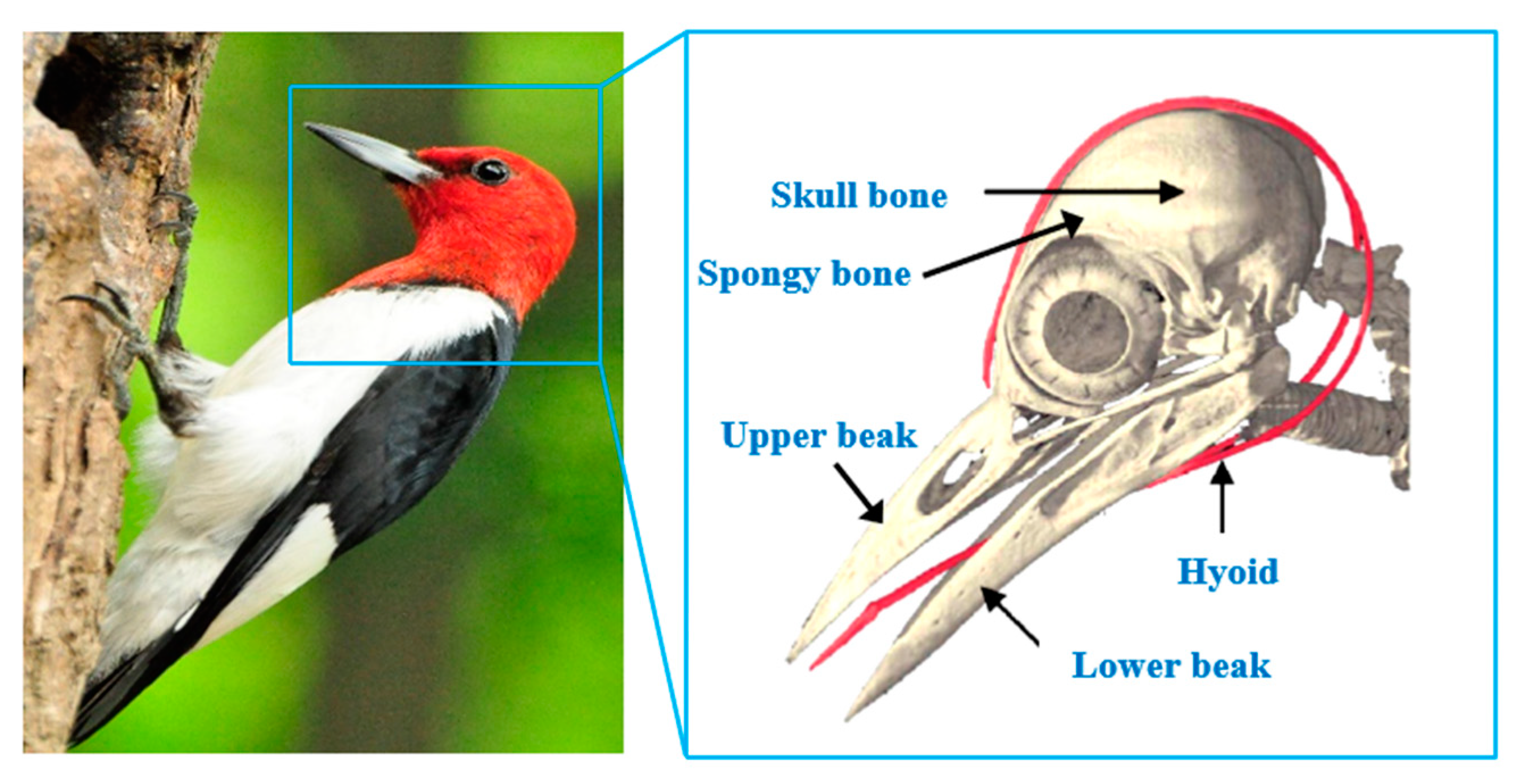
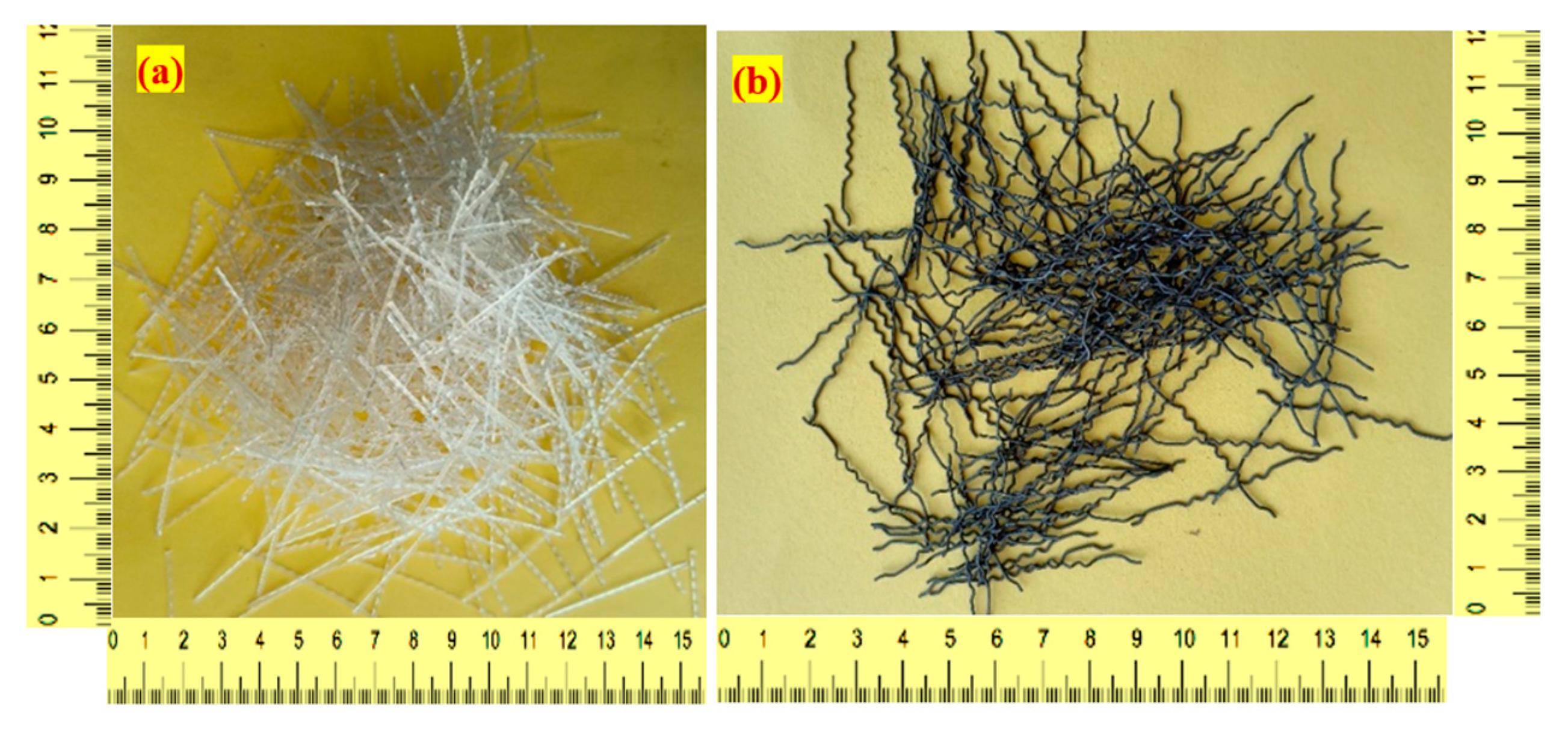
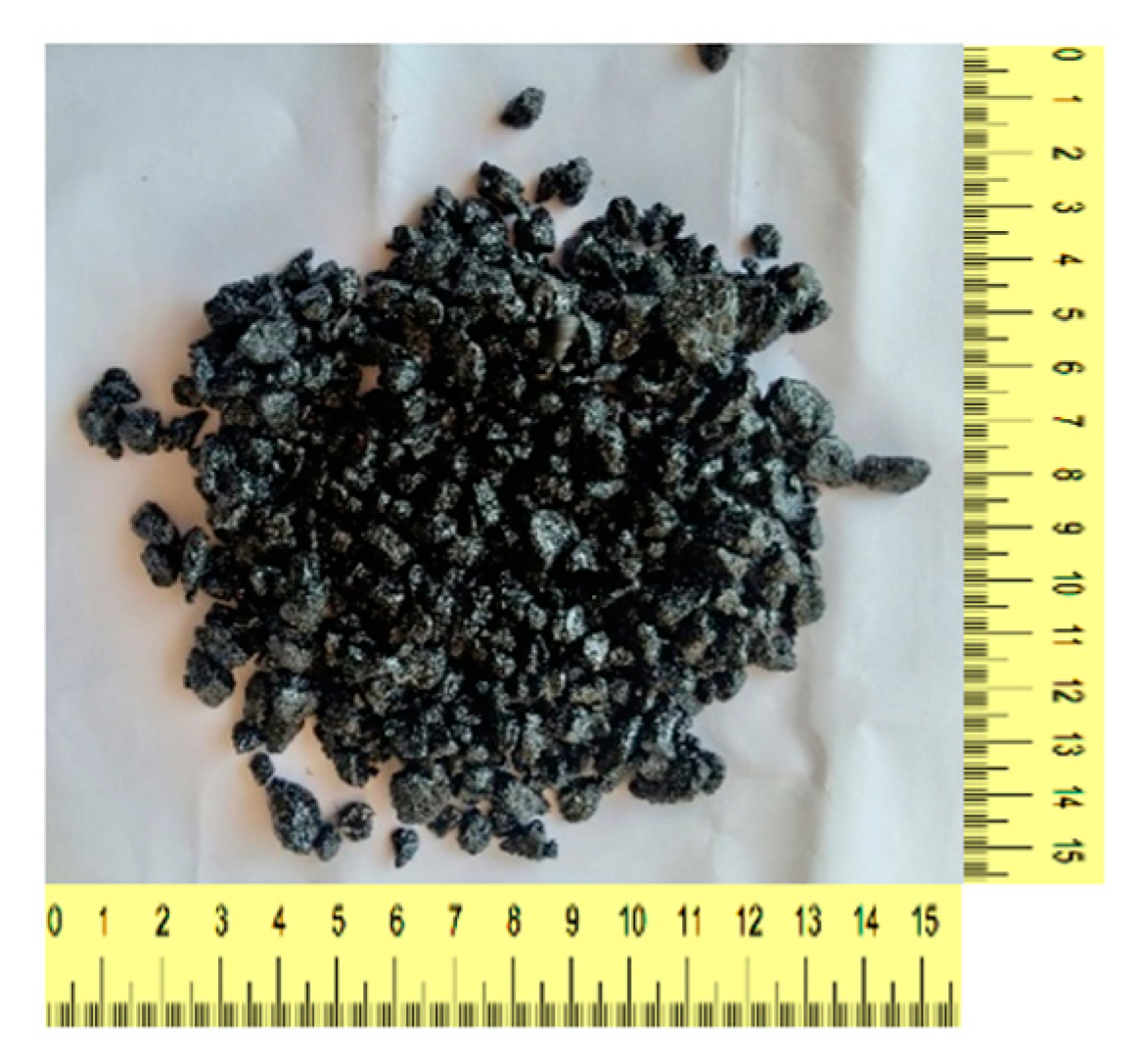

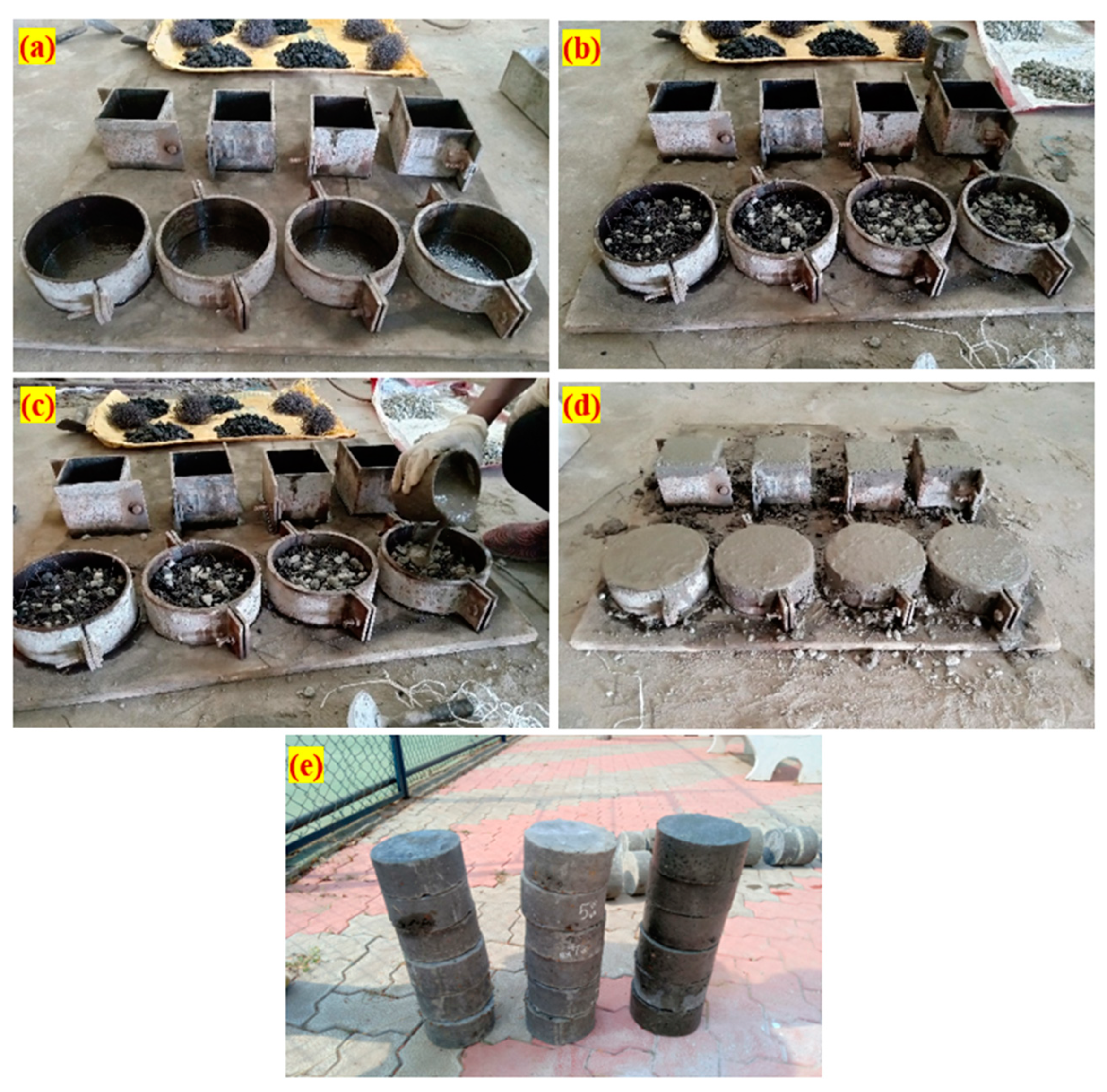

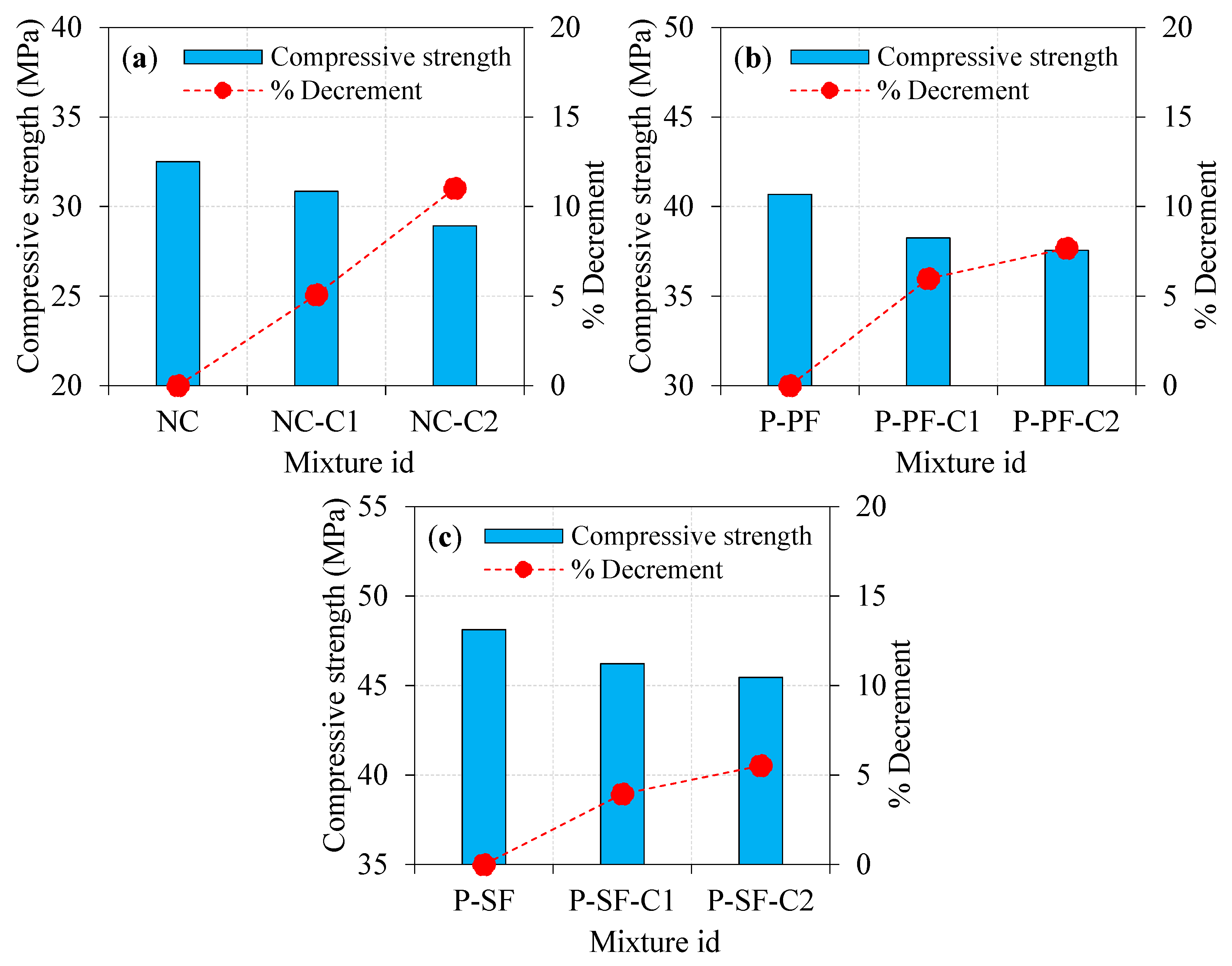
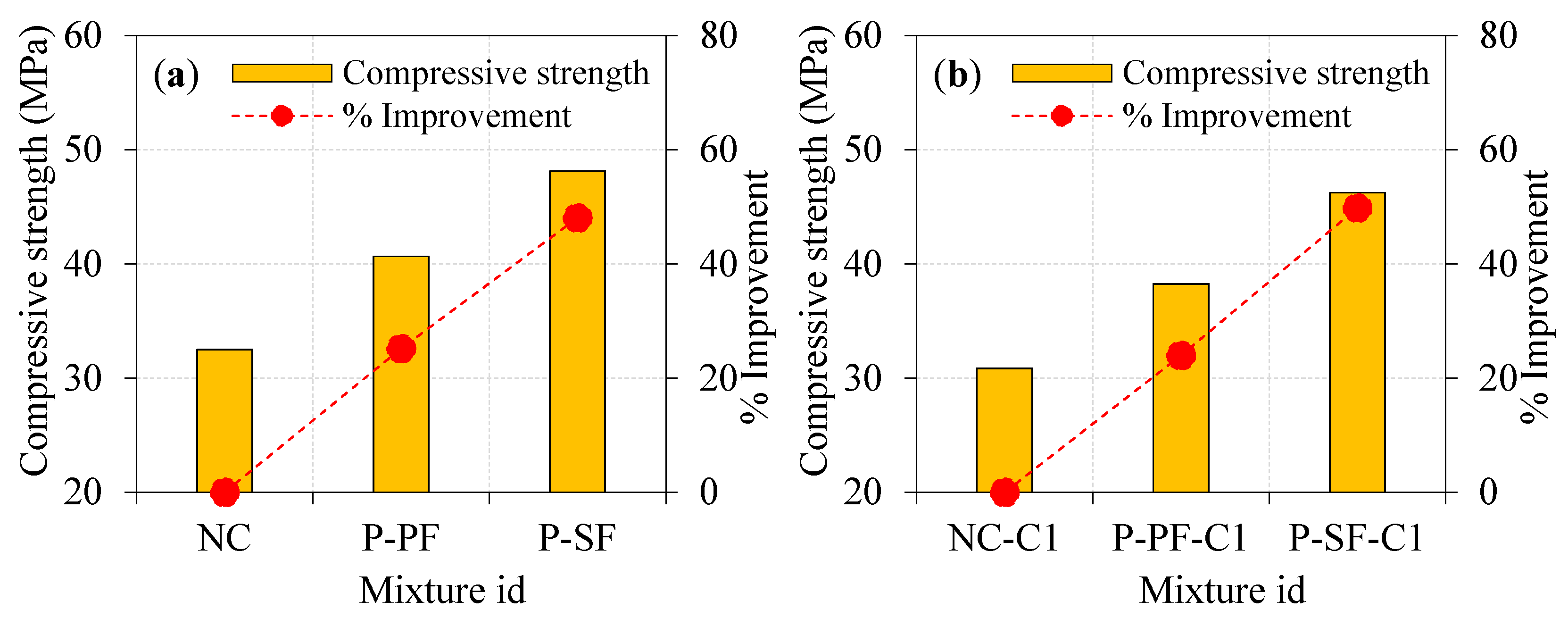
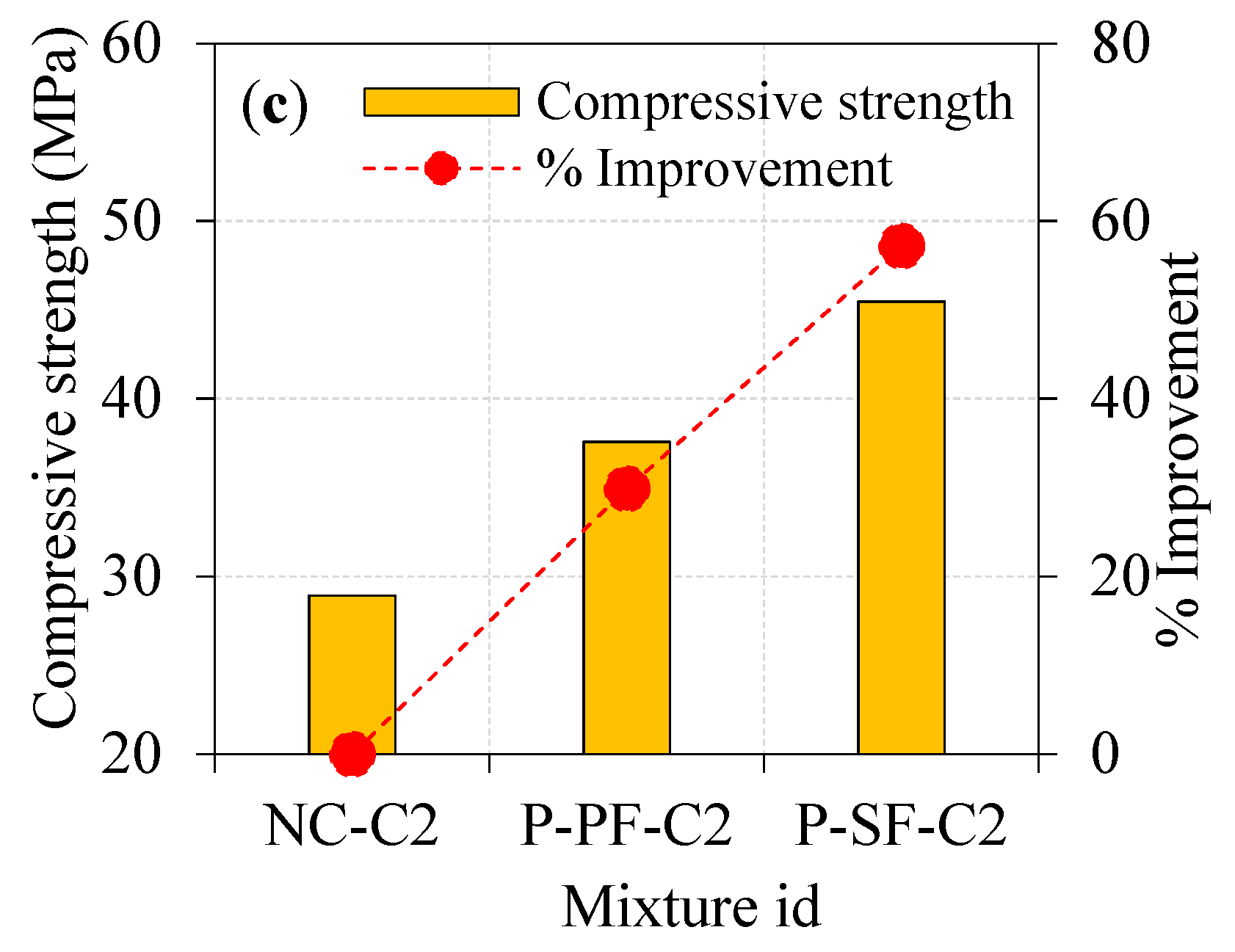

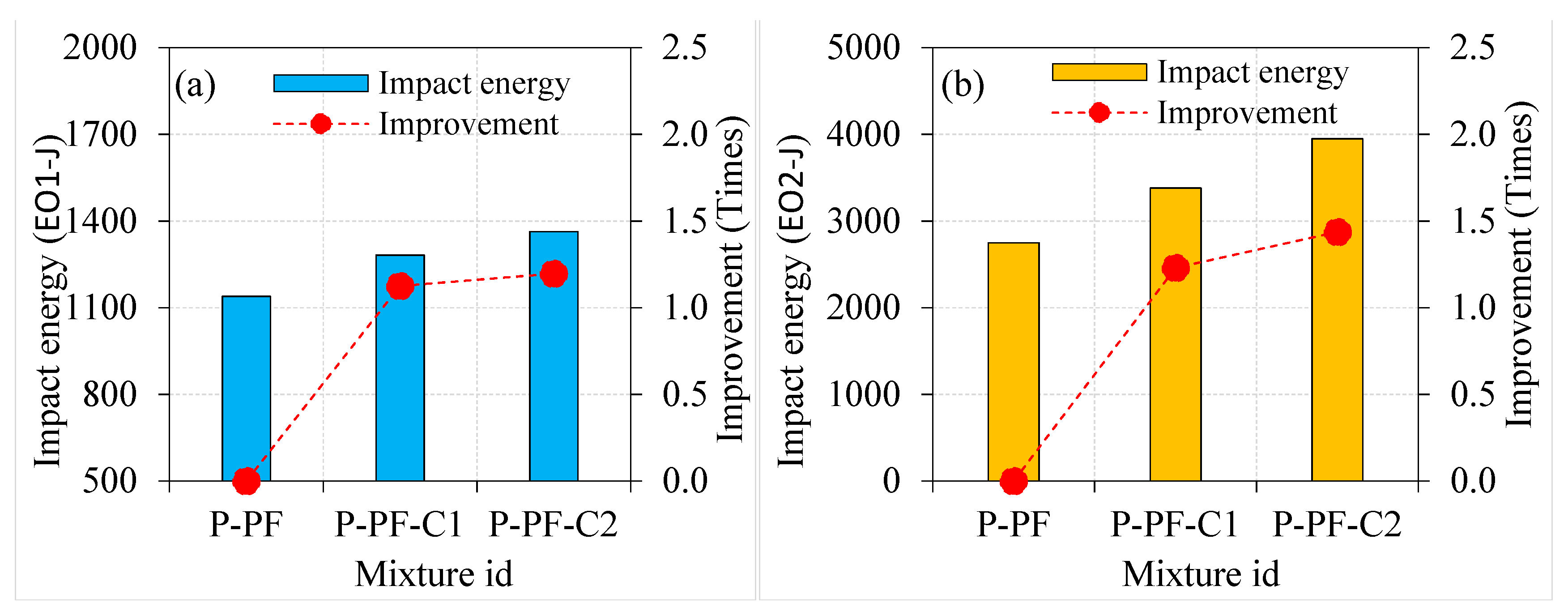
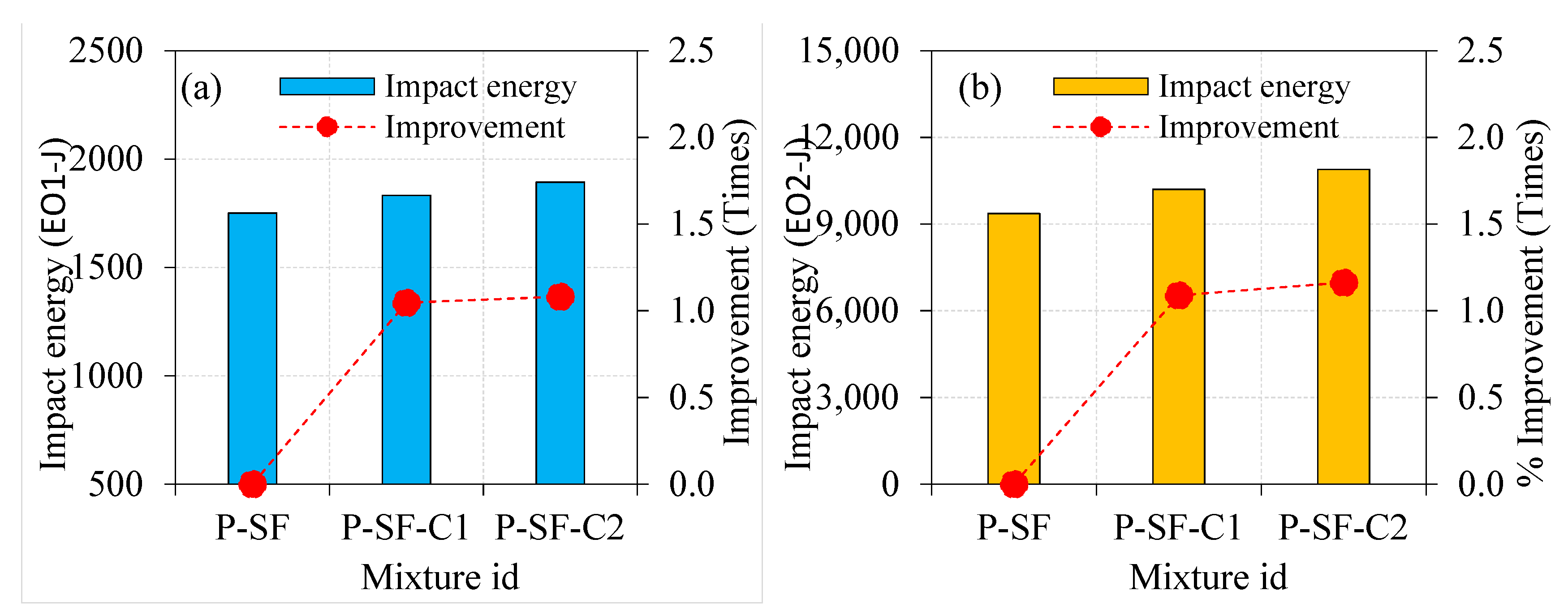

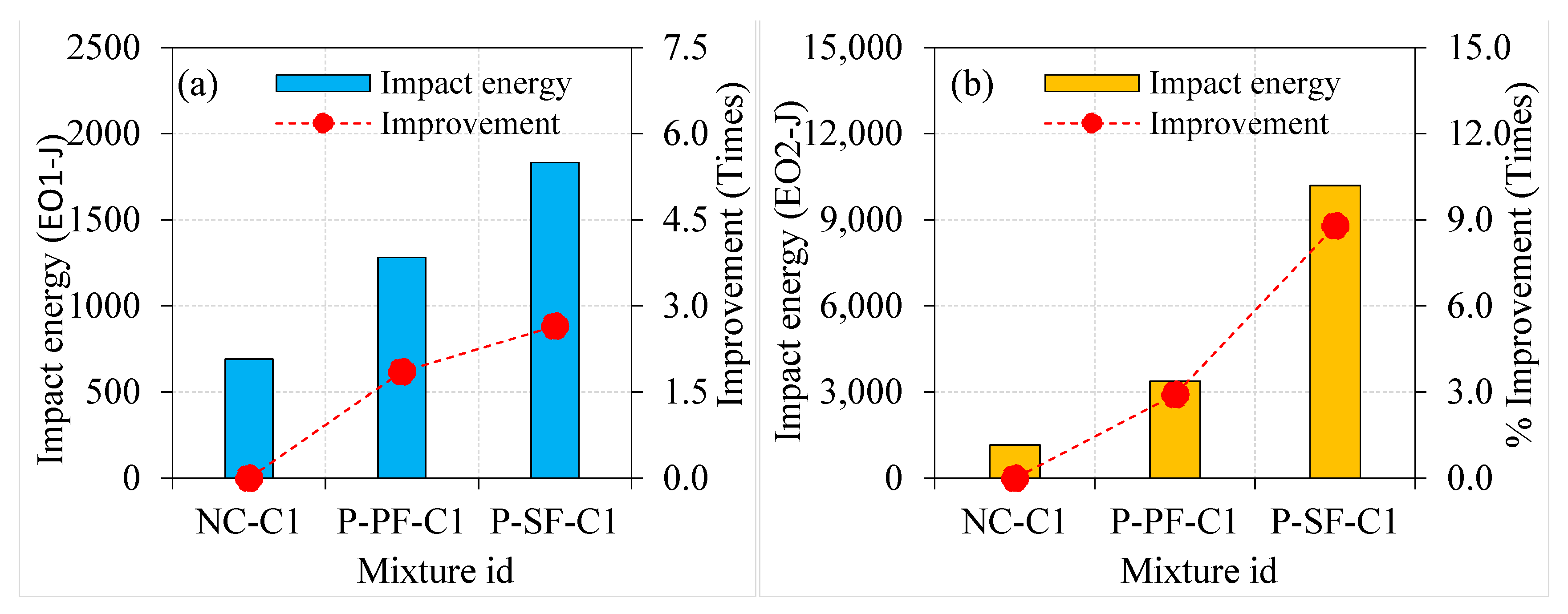
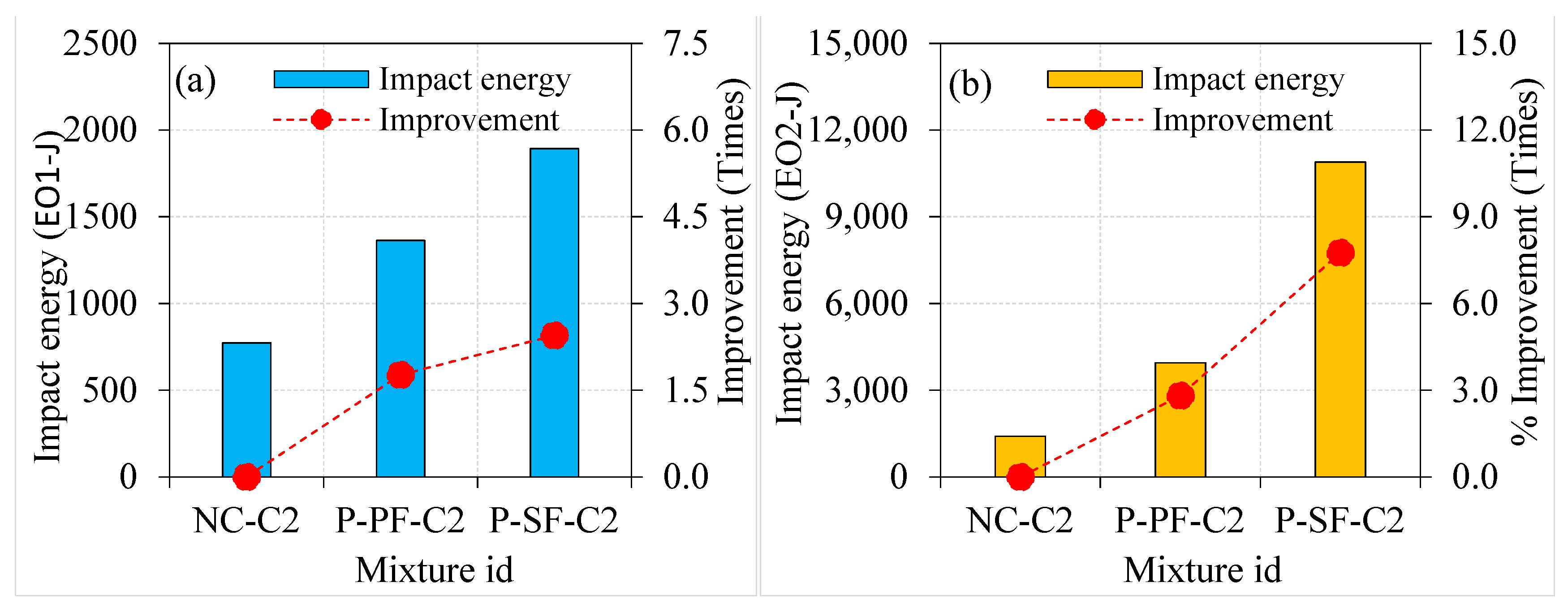
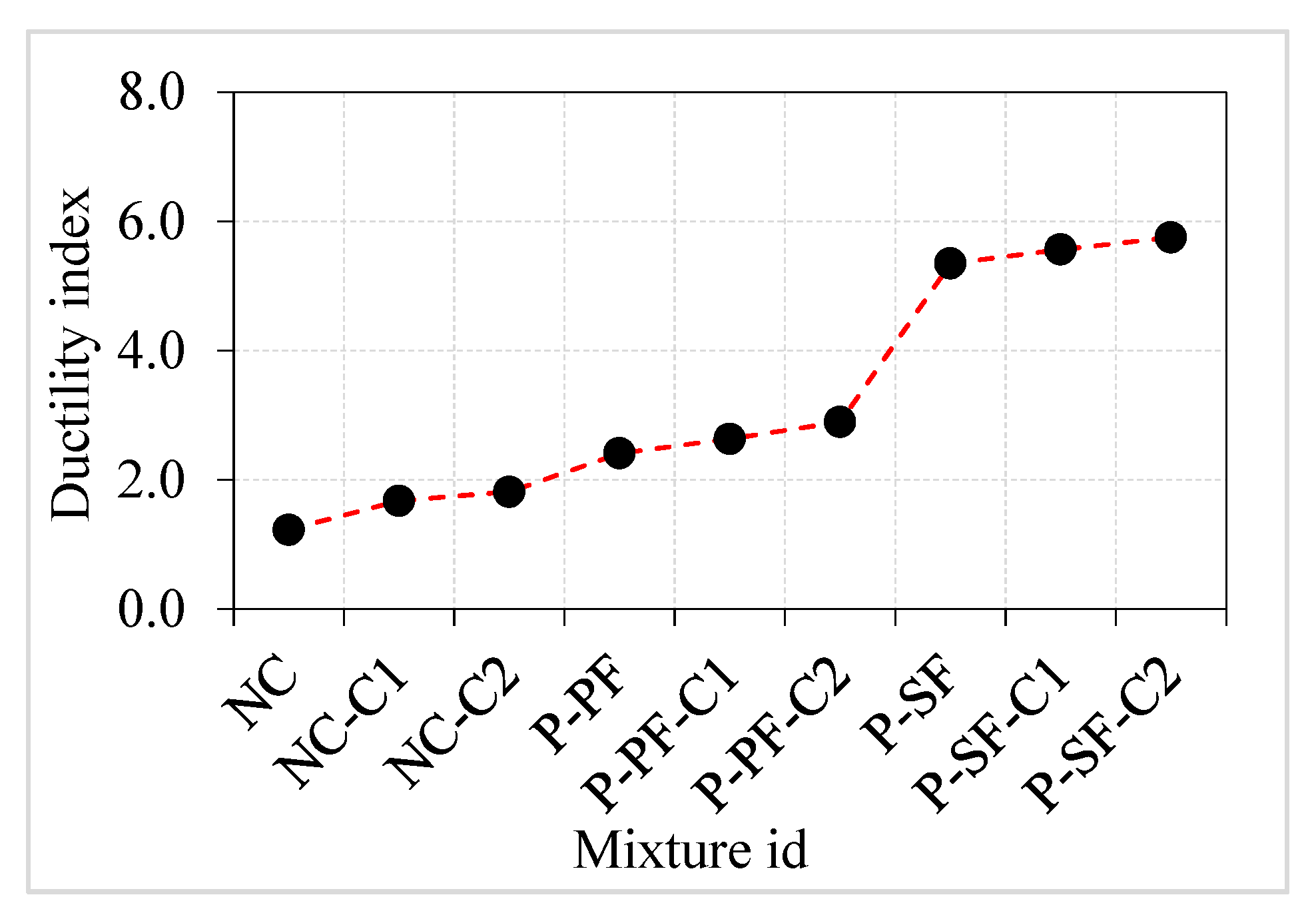


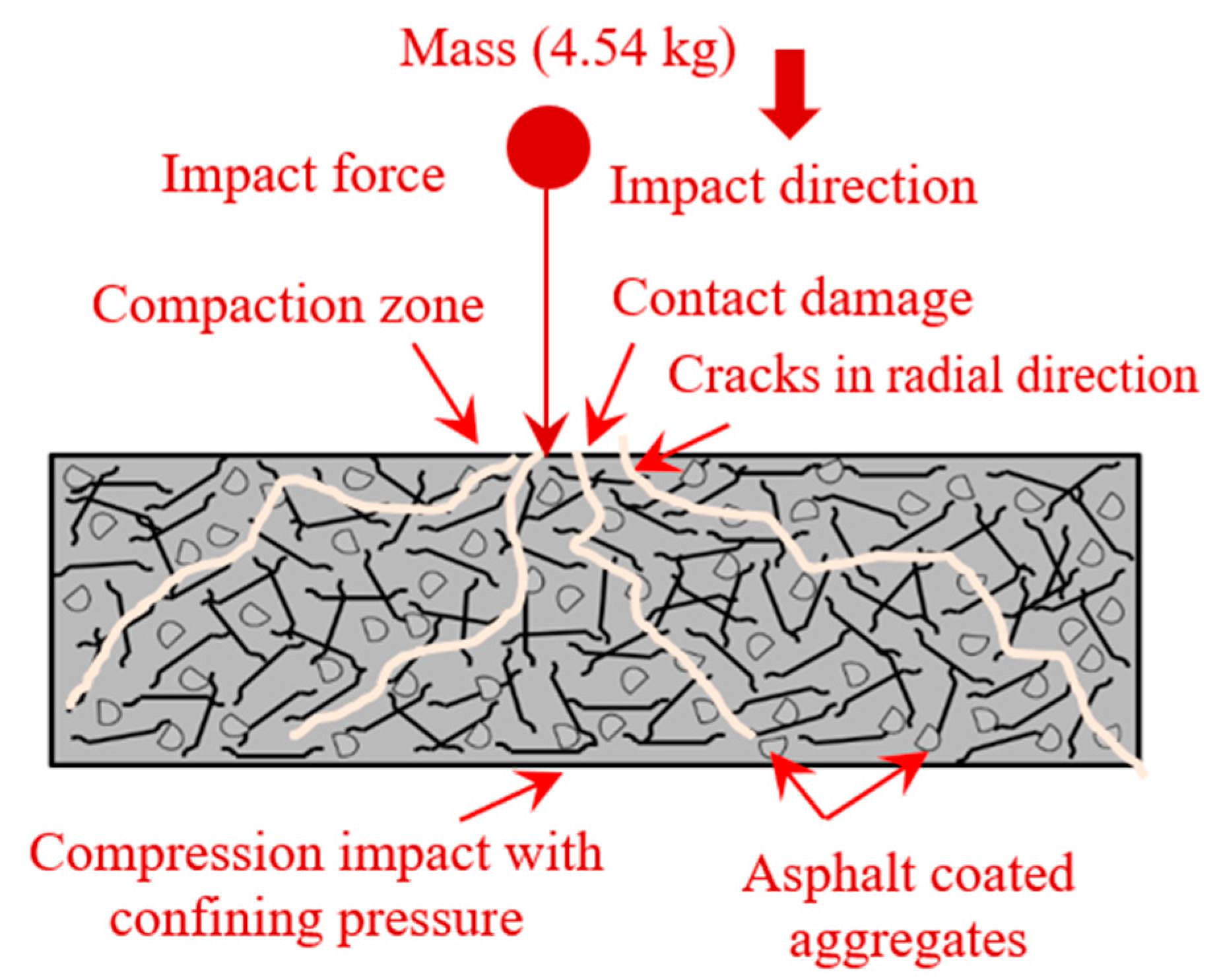
| Standard | Type of Test | Test Results | Recommended Value |
|---|---|---|---|
| IS 1206 (Part 3) [24] | Viscosity (Kinematic) at 135 °C (Cst) | 487 | 400 |
| IS 1206 (Part 2) [25] | Viscosity (Absolute) at 60 °C (poise) | 3999 | 3200 to 4800 |
| IS 1208 [26] | Ductility at 25 °C (cm) | 48 | 25 |
| IS 1206 (Part 1) [27] | Viscosity Ratio at 60° (Cst) | 2.6 | 4 |
| IS 1205 [28] | Softening point (°C) | 50.6 | 50 |
| IS 1203 [29] | Penetration at 25 °C,100 g, 5 s (mm) | 36 | 35 |
| S. No | Mix Id | Cement/Sand Ratio | W/C | Fibre Type | Fibre Dosage * (%) | Fibre Kg/m3 | Asphalt-Coated Aggregate (%) | Number of Asphalt Coating Layers | SP (%) |
|---|---|---|---|---|---|---|---|---|---|
| 1 | NC | 1.0 | 0.42 | - | 0 | 0 | 0 | 0 | 0.3 |
| 2 | NC-C1 | - | 0 | 0 | 100 | 1 | 0.3 | ||
| 3 | NC-C2 | - | 0 | 0 | 100 | 2 | 0.3 | ||
| 4 | P-PF | PF | 3 | 235.5 | 0 | 0 | 0.45 | ||
| 5 | P-PF-C1 | PF | 3 | 235.5 | 100 | 1 | 0.5 | ||
| 6 | P-PF-C2 | PF | 3 | 235.5 | 100 | 2 | 0.5 | ||
| 7 | P-SF | SF | 3 | 235.5 | 0 | 0 | 0.45 | ||
| 8 | P-SF-C1 | SF | 3 | 235.5 | 100 | 1 | 0.5 | ||
| 9 | P-SF-C2 | SF | 3 | 235.5 | 100 | 2 | 0.5 |
| Mixture Id | Impact Numbers | Impact Energy (J) | Ductility Index | ||
|---|---|---|---|---|---|
| O1 | O2 | EO1 | EO2 | ||
| NC | 22 | 27 | 447.8 | 549.5 | 1.2 |
| NC-C1 | 34 | 57 | 692.0 | 1160.2 | 1.7 |
| NC-C2 | 38 | 69 | 773.4 | 1404.4 | 1.8 |
| P-PF | 56 | 135 | 1139.8 | 2747.7 | 2.4 |
| P-PF-C1 | 63 | 166 | 1282.3 | 3378.7 | 2.6 |
| P-PF-C2 | 67 | 194 | 1363.7 | 3948.6 | 2.9 |
| P-SF | 86 | 460 | 1750.4 | 9362.7 | 5.3 |
| P-SF-C1 | 90 | 501 | 1831.8 | 10,197.1 | 5.6 |
| P-SF-C2 | 93 | 535 | 1892.9 | 10,889.2 | 5.8 |
Publisher’s Note: MDPI stays neutral with regard to jurisdictional claims in published maps and institutional affiliations. |
© 2022 by the authors. Licensee MDPI, Basel, Switzerland. This article is an open access article distributed under the terms and conditions of the Creative Commons Attribution (CC BY) license (https://creativecommons.org/licenses/by/4.0/).
Share and Cite
Vatin, N.I.; Murali, G.; Abid, S.R.; de Azevedo, A.R.G.; Tayeh, B.A.; Dixit, S. Enhancing the Impact Strength of Prepacked Aggregate Fibrous Concrete Using Asphalt-Coated Aggregates. Materials 2022, 15, 2598. https://doi.org/10.3390/ma15072598
Vatin NI, Murali G, Abid SR, de Azevedo ARG, Tayeh BA, Dixit S. Enhancing the Impact Strength of Prepacked Aggregate Fibrous Concrete Using Asphalt-Coated Aggregates. Materials. 2022; 15(7):2598. https://doi.org/10.3390/ma15072598
Chicago/Turabian StyleVatin, Nikolai Ivanovich, Gunasekaran Murali, Sallal R. Abid, Afonso Rangel Garcez de Azevedo, Bassam A. Tayeh, and Saurav Dixit. 2022. "Enhancing the Impact Strength of Prepacked Aggregate Fibrous Concrete Using Asphalt-Coated Aggregates" Materials 15, no. 7: 2598. https://doi.org/10.3390/ma15072598
APA StyleVatin, N. I., Murali, G., Abid, S. R., de Azevedo, A. R. G., Tayeh, B. A., & Dixit, S. (2022). Enhancing the Impact Strength of Prepacked Aggregate Fibrous Concrete Using Asphalt-Coated Aggregates. Materials, 15(7), 2598. https://doi.org/10.3390/ma15072598










